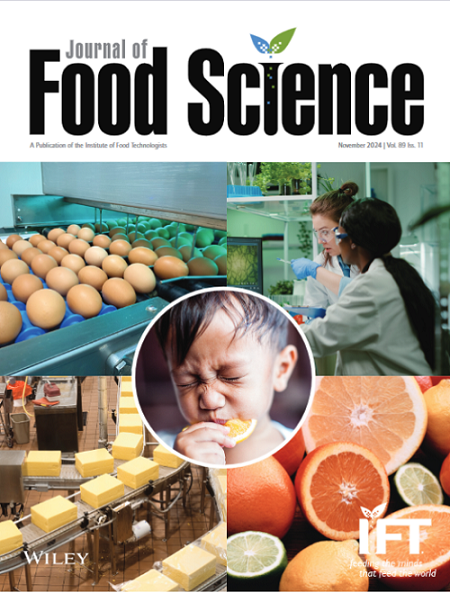Fabrication of SA/CMC composite membrane embedded with ascorbic acid and cross-linked through propylene glycol: The study on the preservation effects on fresh-cut eggplants
Abstract
In this study, sodium alginate/sodium hydroxymethyl cellulose (SA/CMC)-based biodegradable membranes cross-linked with propylene glycol (PG) and incorporated with ascorbic acid (AA) were synthesized. The color, morphology, water vapor permeability (WVP), and antioxidant capacity of every kind of membrane were investigated. The morphological characterization affirmed that the resultant blend membranes exhibited a well-organized homogeneous structure without cracks. Moreover, the antioxidant capacity increased with increasing concentration of AA in the obtained membranes. The increase in the concentration of AA affected the WVP of the blended membranes. The weight loss rate, total soluble solid, total phenol, and MDA content of the SA/CMC/PG/1.0% (v/w) AA experimental groups were 15 ± 0.02%, 4.891 ± 0.04%, 0.59 ± 0.05 mg g−1, and 0.174 µmol g−1, respectively. Hence, the release and DPPH radical scavenging assay of incorporating AA in SA/CMC/PG membrane showed that the obtained SA/CMC/PG membrane with 1.0% AA can release AA slowly and have strong antioxidant activity. Thus, 1.0% AA incorporated into SA/CMC/PG membrane was an effective method to establish an active and environmentally friendly food packing material.
Practical Application
We established sodium alginate/sodium hydroxymethyl cellulose (SA/CMC)-based biodegradable membranes incorporated with ascorbic acid (AA) and cross-linked with propylene glycol (PG). After being characterized, the SA, SA/CMC, SA/CMC/PG, 0.2% (v/w) AA/SA/CMC/PG, and 1.0% (v/w) AA/SA/CMC/PG membrane were applied to preserve the fresh-cut eggplants. Though the determination of the total soluble solid, total phenol content, and malondialdehyde content in purple eggplant during the 8 days of storage, the result shows that the obtained sodium alginate/sodium hydroxymethyl cellulose/propylene glycol/1% (v/w) AA composite membranes have a potential application in active food packaging.

 求助内容:
求助内容: 应助结果提醒方式:
应助结果提醒方式:


